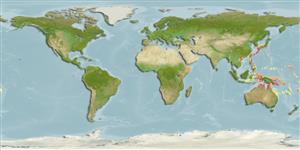分類 / Names
俗名 | 同種異名 | Catalog of Fishes(屬, 種) | ITIS | CoL | WoRMS | Cloffa
Teleostei >
Blenniiformes (Blennies)
鱸形目 (Blennies) >
Blenniidae (Combtooth blennies)
鳚科 (Combtooth blennies) > Salariinae
Etymology: Praealticus: Latin, prae = in front of + Latin, altus, alticus = nutritious.
Eponymy: This is a toponym referring to Tanegashima, Osumi Islands, Japan, type locality [note spelling, without “h”]. (Ref. 128868), visit book page.
More on authors: Jordan & Starks.
Environment: milieu / climate zone / depth range / distribution range
生態學
海洋 居於水底的. 熱帶
Western Pacific: southern Japan, Taiwan, and Guam.
西太平洋: 日本南部,台灣與關島。
大小 / 重量 / 年齡
Maturity: Lm ? range ? - ? cm
Max length : 5.9 cm SL 雄魚/尚未辨別雌雄; (Ref. 28618)
背棘 (總數) : 13; 背的軟條 (總數) : 17 - 19; 臀棘: 2; 臀鰭軟條: 18 - 19. Nasal cirrus simple and supraorbital cirrus long, a little pinnate. Nuchal cirrus absent. Occipital crest in male, none in female. Some oblique lines distinct on cheek.
鼻的卷鬚單一而眶上的卷鬚長的, 稍微羽狀。 頸背的卷鬚不存在。 在雄魚中的上枕山脊, 母魚沒有。 一些斜線在頰上明顯的。
Facultative air-breathing (Ref. 126274); Adults inhabit surge, rocky shore areas. Grow to less than 14 cm TL. Oviparous. Eggs are demersal and adhesive (Ref. 205), and are attached to the substrate via a filamentous, adhesive pad or pedestal (Ref. 94114). Larvae are planktonic, often found in shallow, coastal waters (Ref. 94114).
棲息於湧浪,岩岸區域。 生長少於 14 公分TL 。 卵生的.(參考文獻 205)
Life cycle and mating behavior
成熟度 | 繁殖 | 產卵場 | 卵 | 孕卵數 | 仔魚
Oviparous, distinct pairing (Ref. 205).西太平洋: 日本南部,台灣與關島。
Masuda, H., K. Amaoka, C. Araga, T. Uyeno and T. Yoshino, 1984. The fishes of the Japanese Archipelago. Vol. 1. Tokai University Press, Tokyo, Japan. 437 p. (text). (Ref. 559)
IUCN 瀕危狀態 (Ref. 130435: Version 2024-1)
無危 (LC) ; Date assessed: 27 March 2009
人類使用
工具
特別的報告
下載 XML
網路資源
Estimates based on models
Preferred temperature (Ref.
123201): 20.7 - 28.5, mean 25.4 °C (based on 257 cells).
Phylogenetic diversity index (Ref.
82804): PD
50 = 0.5001 [Uniqueness, from 0.5 = low to 2.0 = high].
Bayesian length-weight: a=0.01047 (0.00461 - 0.02381), b=2.98 (2.79 - 3.17), in cm total length, based on LWR estimates for this (Sub)family-body shape (Ref.
93245).
營養階層 (Ref.
69278): 2.0 ±0.00 se; based on food items.
回復力 (Ref.
120179): 高度, 族群倍增時間少於 15個月 (Preliminary K or Fecundity.).
Fishing Vulnerability (Ref.
59153): Low vulnerability (10 of 100).
